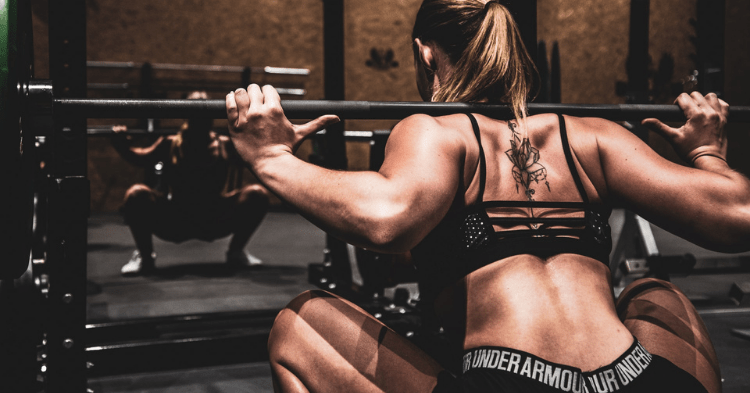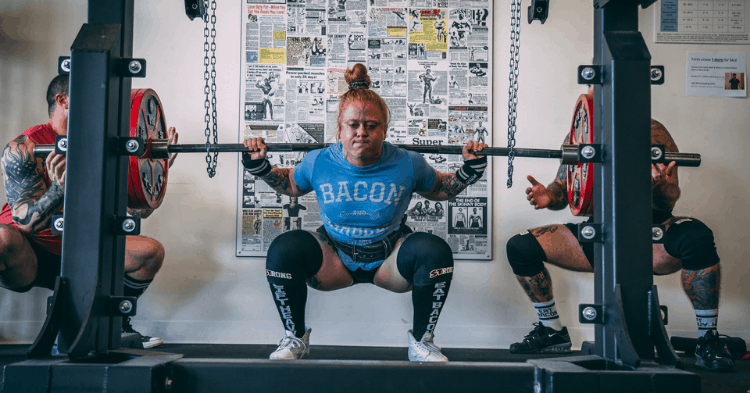An improved squat depth requires you to increase the depth your hips drop to during a deep squat. A deep squat starts below the height of your knees and increases as you gain more depth. Improving the depth of squats is a challenge for many lifters due to the muscle control required. Deep squats with weights are an especially difficult workout but improvement is possible if you follow the right strategies.

Three strategies improve squat depth. The first is focused mobility training, the second is squatting to a box, and the third is practicing over weights. Hitting depth is the bane of many lifters’ existence, so it’s important to incorporate strategies that specifically target increased squat depth.
Below, we’ll go over everything you need to know about how deep your squat should be, strategies to fix them, and potential barriers limiting your squats.
Contents
How deep should your squats be?
The controversy surrounding squat depth leaves many athletes wondering how deep their squats should be and whether a deeper squat is more effective. There is no right or wrong answer, but there are a few variables to consider when working on your squat depth.
Generally speaking, the goal should be to break parallel. You are at parallel when your thighs are parallel to the floor— basically a seated position. To break parallel, your hip crease should be slightly below your knees— this is the depth standard used in powerlifting judging around the world.
Beyond breaking parallel, you have the freedom to determine how low you go. For Olympic lifters and crossfitters, the extremely deep squat makes sense for the complexity of Olympic movements. That level of depth isn’t necessary for competitive powerlifters; it’s all about exploring where you’re the strongest in your range of motion.
3 Tips for improved squat depth
When trying to figure out how to increase squat depth, three focal points target the main barriers to a deep squat. Use the following three strategies together for a stronger, deeper squat.
1. Focused mobility training
Xem bài viết này trên Instagram
The first strategy that helps improve squat depth is focused mobility training. The strategy involves focusing on dynamic warm-up movements that target the hips and ankles. Many people mistakenly think that they have a hip issue limiting their squat depth when their ankles are actually the source of the problem.
Static stretches have a place in training, but dynamic movements that help you improve flexibility and mobility are essential for a deeper squat. Ankle PAIL/RAILs and CARs are fantastic starting points for exercises that improve squat depth. When in doubt, reach out to an experienced mobility coach.
2. Squat to a box
 &feature=youtu.be
&feature=youtu.be
The second strategy you should incorporate to improve squat depth is squatting to a box. Squatting to a box helps improve the mind-body connection and spatial awareness so that you recognize when you’ve hit depth. It can also help you improve your confidence and overcome fear as a new lifter. Start with a box set up at depth, then lower it slightly once you gain confidence in the movement.
It’s important to note the difference between squatting to a box and a “box squat.” A box squat is a practical training exercise that takes the momentum out of the equation and improves strength in the posterior chain. When squatting to a box to improve depth, you are doing a touch-and-go movement rather than sitting down entirely.
3. Practice form over weights

The third and final strategy to improve squat depth is by practicing your form over weights. Keep your ego in check and don’t push the weights until you’re ready. Rather than trying too hard to adjust your strength to a program, adjust the program to your pace. Don’t push the weights until you can complete your full set with good form at your current weight.
Consider working with an experienced trainer or coach who will help you modify your movements and programming to maintain proper form. If you’re training alone, take videos from various angles to determine whether you’re hitting depth and if your form needs work.
What’s limiting your squat depth?

Many variables can limit your squat depth. Below are a few common issues to consider while troubleshooting your squat.
Starting too heavy
Starting too heavy will severely limit your squat depth by putting too much pressure on your body. Don’t let your ego limit your potential in the gym. If you can’t hit depth with the weight you’re pushing, drop the weights and work on building strength over time. A heavy squat isn’t impressive if you’re only coming down a quarter of the way.
If you’re working with an empty bar and still having issues with depth, there’s likely another problem to address.
Inadequate core bracing
Inadequate core bracing keeps you from improving both your squat depth and squat weight. Squats are a complex, compound movement. While we tend to think of them as a lower body exercise, squats engage the core and upper body as well. Building core strength and learning how to brace will help you stay upright while squatting with heavy weights. If you feel shaky coming down or tilting forward, working on core bracing can be beneficial.
Squat stance
Adjusting your squat stance helps you improve your depth by opening the hips. Take a step out to either side and try the movement again to improve your center of gravity. One caveat when trying this approach to improving squat depth: adjusting your stance to compensate for other issues will only take you so far. Use this approach to keep squatting while fixing the other issues.
Lack of spatial awareness
A lack of spatial awareness limits your squat depths by preventing a conscious understanding of your muscle control. Many people struggle with increasing squat depth because they don’t know where their body is during a movement. If you don’t know what your body feels like when it breaks parallel, you won’t know when you’ve hit depth.
Fear
Fear poses a major limitation in improving squat depth. Lifting weights is often a mental exercise as well as a physical exercise. Fear of getting hurt, failure, or embarrassment often causes new lifters to come up too early during a squat. Taking your time with progression, ensuring you have safety measures in place, and building confidence will help.
Mobility issues
The most significant cause of unimproved squat depth is mobility issues. A mobility barrier often gets confused with flexibility problems. It’s essential to know the difference between flexibility and mobility to start correcting these issues.
Flexibility is the stretching of your muscles and tendons during movement. On the other hand, mobility pertains to joint movement and strength throughout your entire range of motion. If your mobility and warm-up routine consist of foam rolling for twenty minutes, you’re setting yourself up for failure. Dynamic, targeted movements are essential for improving squat depth.
Conclusion
Improving your squat depth takes time, knowledge, and focus. Rather than solely trying to improve flexibility for squats, focus on your overall mobility and the mind-body connection. Remember that squats are a compound movement that works the whole body. As such, you’ll need to support your entire body to improve your squat.